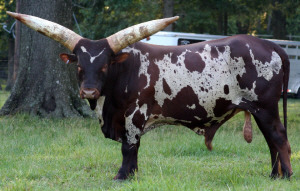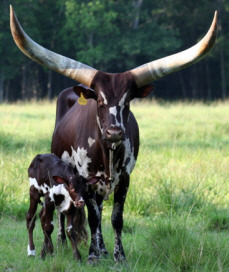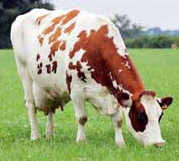



Watusi
History
Long-horned, 'humpless' domestic cattle were well established in the Nile Valley by 4000 BC. These cattle, known as the Egyptian or Hamitic Longhorn, appear in pictographs in Egyptian pyramids. Over the next 2000 years, the Egyptian Longhorn migrated with its owners from the Nile to Ethiopia, and then down to the southern reaches of Africa.By 2000 BC, humped cattle (Longhorn Zebu) from Pakistan and India reached Africa.
 Photo courtesy of The World Watusi Association, watusicattle.com |
Particularly remarkable are the cattle found in Uganda, Rwanda, and Burundi. In Uganda, the Nkole tribe's Sanga variety is known as the Ankole. In Rwanda and Burundi, the Tutsi tribe's Sanga variety is called the Watusi. The Rwanda common strain of Watusi is called Inkuku. The giant-horned strain, owned by the Tutsi kings and chiefs, is called the Inyambo, though some current tribal reports claim that this type is now extinct.
Traditionally, Ankole-Watusi were considered sacred. They supplied milk to the owners, but were only rarely used for meat production, since an owner's wealth was counted in live animals. Under traditional management, the Ankole cow was grazed all day, then brought home to her young calf. The calf was allowed to suckle briefly to stimulate milk letdown, then the cow was milked by the herdsman. The calf suckled after hand-milking was finished and was again separated from its mother. The process was repeated in the morning. This minimal nourishment of calves resulted in high death rates in the young. Milk production was not high, with a typical cow producing only 2 pints of milk daily, although an exceptional one could manage up to 8 pints. In addition, the lactation period was short. Over the last 10 years, the national government has attempted to select for animals which produce more milk and have better meat production. Famine and disease, as well as the conflict with traditional practices, have slowed this effort.
Watusi Cattle Outside of Africa
Because of their striking appearance, and the resulting ability to attract paying customers, Ankole cattle were imported from Africa by European zoos during the late 19th and early 20th centuries. Zoos and game parks in Germany, Sweden, and England were among the breeders of these cattle outside Africa. The cattle were called Ankole, or Ankole-Watusi, and they were treated as a single breed. American zoos and other tourist attractions imported Ankole-Watusi cattle from European zoos in the 1920's and 1930's. As time went on, and zoos began to change their emphasis from visually-exciting animals to those (wild) animal species in desperate need of preservation, more Ankole-Watusi cattle became available for sale to private individuals and several private herds were begun.
In January, 1983, North Americans interested in the Ankole-Watusi cattle breed met in Denver, Colorado, and formed the Ankole Watusi International Registry. Within five months, the Registry had 74 members nationwide. These members shared a strong commitment to the breed, though they had different priorities for it. Some wanted to concentrate solely on the prevention of breed extinction; some selected for their utility in the production of superior cross-bred roping animals. Still others championed the low-fat and low-cholesterol meat values after these were discovered.
Watusi cattle are the show-stoppers of the bovine kingdom, they attract attention wherever they appear. These regal animals can easily trace their ancestry back more than 6,000 years and have often been referred to as "cattle of kings."
Characteristics
The Watusi appear elegant, well-bred, and graceful. They have a straight topline and a sloping rump, and sometimes a neck hump. Watusi may be solid or spotted in colour, their horns are long and symmetrical, with a base large and proportional to horn length. The Watusi is medium in size, with cows weighing 900 - 1200 pounds and bulls weighing 1000 - 1600 pounds. Newborn calves weigh 30 - 50 pounds. This small birth-weight makes Watusi bulls useful for breeding to first-calf-heifers of other breeds.The milk is about 10 percent fat. Some dairy farmers have used crossbred Watusi cows in their herds to boost the butter-fat levels. Because they were developed in a climate where daily temperatures may range from 20 to 120oF, Watusi tolerate temperature and weather extremes well. The large horns act as radiators; blood circulating through the horn area is cooled and then returned to the main body. This allows excess body heat to be dispersed.
Statistics
 Photo courtesy of The World Watusi Association, watusicattle.com |
Comparative
Three meat studies have been done and the results have been good for the breed. Watusi meat has been demonstrated to be very low fat and to have lower cholesterol than other commercial beef. These studies will continue, because the AWIR has the establishment of utility value as a high priority. This will be a way to protect the market for breeding stock as "curiosity" prices begin to disappear.Distribution
The Watusi breed is mainly bred in the USA and Africa.References (the above information was cited from the following sites)
www.ansi.okstate.edu
watusicattle.com
www.awir.org


